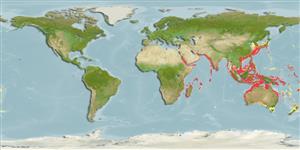Common names from other countries
Classification / Names / Names
Populaire namen | Synoniemen | Catalog of Fishes (gen., sp.) | ITIS | CoL | WoRMS
Environment: milieu / climate zone / depth range / distribution range
Ecologie
; diepteverspreiding 60 - 399 m (Ref. 78901), usually 60 - 200 m (Ref. 76930). Tropical
Indo-West Pacific: Red Sea to Japan, Philippines and Indonesia. Pérez Farfante (Ref. 75620) recognizes 3 subspecies: Parapenaeus fissuroides fissuroides from Indonesia to Japan and the Philippines, Parapenaeus fissuroides erythraeus from the Red Sea and Parapenaeus fissuroides indicus from east Africa and Madagascar.
Length at first maturity / Size / Gewicht / Leeftijd
Maturity: Lm ? range ? - ? cm Max length : 2.7 cm CL mannelijk/geslacht niet bekend; (Ref. 119007); 3.61 cm CL (female)
Found in high salinity and high temperature areas (Ref. 76930).
Life cycle and mating behavior
Geslachtsrijpheid | Voortplanting | Kuitschieten | Eieren | Fecundity | Larven
Members of the order Decapoda are mostly gonochoric. Mating behavior: Precopulatory courtship ritual is common (through olfactory and tactile cues); usually indirect sperm transfer.
Pérez Farfante, I. and B. Kensley. 1997. (Ref. 75620)
Status op de Rode Lijst van het IUCN (Ref. 130435)
Status bij CITES (Ref. 108899)
Not Evaluated
Not Evaluated
Gebruik door de mens
| FishSource |
Tools
Internet-bronnen
Estimates based on models
Weerstandsvermogen
Hoog, minimale populatieverdubbelingstijd minder dan 15 maanden (K=0.94-1.01; tm=1).
